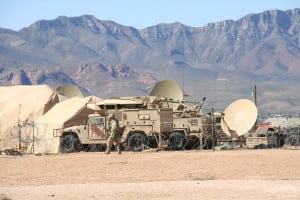The Army’s tactical network modernization team is opening its search to find new technologies to be included in its second capability drop in fiscal year 2023, meeting with industry this week in Austin, Texas ahead of a call for white papers next month and “Shark Tank”-like pitch event in February.
Army officials told reporters on Thursday the Network Cross Functional Team’s Capability Set (CAPSET) 23 will look to find new solutions to expand the team’s work to build an integrated tactical network, including low and mid-Earth orbit satellite technologies, range extension capabilities and network resiliency tools, and continue finalizing the new common operating environment for soldiers.

Maj. Gen. Pete Gallagher, director of the Network CFT, noted this is the fourth technical exchange meeting since his team was stood up in October 2017, with this event geared toward updating industry on FY ’23.
“This is the biggest one we’ve ever had. We have 672 people here today, which is fairly significant,” Gallagher said.
The Network CFT has previously announced its plan to refocus its modernization initiative around dropping in new capabilities every two years, beginning with CAPSET 21.
Officials said this week’s industry event is an opportunity to detail CAPSET 23 technologies that will build on the work currently being prototyped and experimented, including expanding the integrated tactical network focus from infantry brigade combat teams to also include armored brigade requirements.
“What we’re looking to do is really improve and converge out network operations and cyber security posture and network management systems. We’ve had some good dialogue about that thus far as we look forward to reduce the number of tools to make sure we can optimize how we plan and operate and defend our networks,” Gallagher said.
Col. Garth Winterle, PEO C3T’s project manager for tactical radios, told reporters the Army will release a call for white papers in mid-December and accept proposals through mid-January to find potential CAPSET 23 technologies.
By the end of January, the Army will invite select companies to pitch their solutions to a “Shark Tank-like” panel in February, before making a downselect to award OTAs for prototyping and experimentation.
“Initial feedback I’ve gotten from several vendors is they’re onboard to move out rapidly and meet our tight timeline to try to get as much data as possible out of our small-scale experimentation by the end of the calendar year in December 2020 in order to support the preliminary design reviews scheduled for April 2021,” Winterle said.
Gallagher told reporters his team is especially interested in low and mid-Earth orbit technologies with plans to start preliminary experimentation over the next few months, and understand capabilities that may be available for CAPSET 23.
“We want to be postured to leverage where industry’s going in space with low-Earth orbit and mid-Earth orbit satellite constellations, and make sure that we have that capability. We want to make sure we can get that on the move, especially for those armored brigade formations. We’re not sure if that will be ready for [CAPSET] 23, but we’re definitely putting a focus on that,” Gallagher said.
Additional technology areas of interest for the next capability set include alternative options for range extension, including unmanned platforms like Gray Eagle or high-altitude balloons, as well as anti-jamming capabilities to harden networks.
For CAPSET 21, the Network CFT will begin a two-week soldier touchpoint exercise at the end of January before moving toward a critical design review in April.
Gallagher and Winterle noted that if Congress is able to pass a defense appropriations bill before the start of the new year the Army should be able to deliver technologies under CAPSET 21 on time and begin CAPSET 23 efforts, while noting a continuing resolution will likely slow down the process.
“The challenge is the continuing resolution and where we stand right now. Hopefully, we’ll have a budget by then. One of the challenges right now is our prototyping resources are considered a new start, and so there will be an impact as long as there is a continuing resolution,” Gallagher said. “It won’t stop us from doing the Shark Tank. It’ll just maybe delay when we can start putting some of the solutions on contract. If we get a budget by the first of the year, I think we’ll be okay for the [CAPSET 23] prototyping effort. If we can start putting things on contract by March, we’re probably in a pretty good situation.”